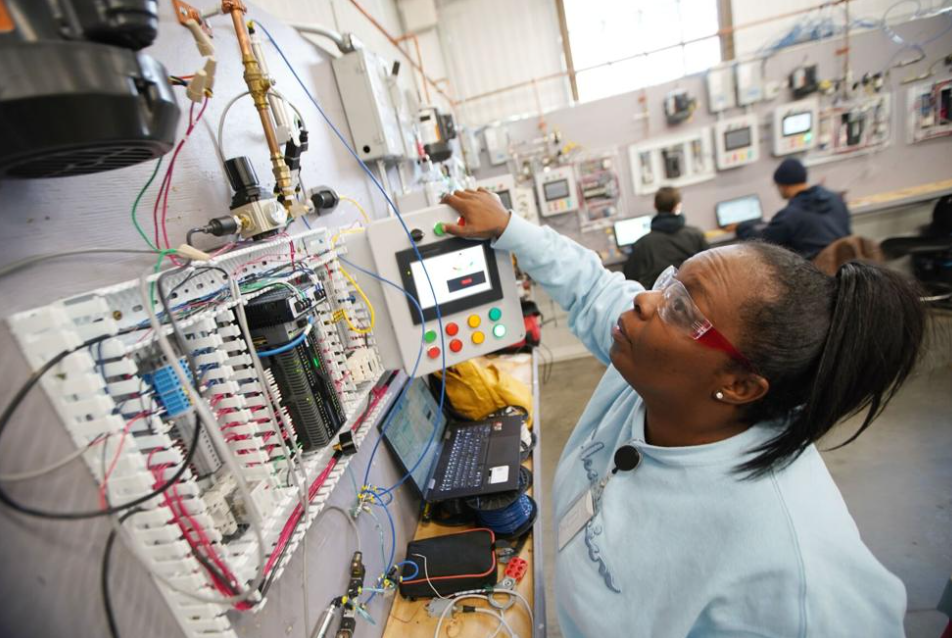Many of the students learning electrical, welding and machining skills at Northland Workforce Training Center in Buffalo weren’t raised to do their own home, car or appliance repairs like previous generations were.

NOT YOUR GRANDPARENTS’ TECH TRAINING: HIGHER ED CATERS TO NEW INDUSTRY AND STUDENT NEEDS
02.27.24
Story originally published February, 2024 via The Buffalo News
By Janet Gramza
Photos by Derek Gee
Instead, the kids graduating from high school today have mostly grown up immersed in computer, video and digital technologies that their grandparents couldn’t have imagined using to fix a car or make machine parts.
Today, people with both skill sets are needed to fill jobs in fast-growing industries like advanced manufacturing, automotive technology and clean energy, where computer programs and robotic assistants are part of the tool kit, says Jeffrey Stevens, dean of Alfred State College’s School of Applied Technology.
“We need to understand that, for example, when you drive a car today, you still turn the wheel and push the gas like you did for a Model T, but there’s a whole lot of difference between a Model T and a Tesla,” Stevens said. “We are teaching kids the fundamentals – I’m teaching them how to use a hammer and how to properly stand on a ladder – but what we add into that is the new technology and the new opportunities that exist today,” he said.
Alfred State is among several partner institutions offering training courses at Northland that are becoming a new model for higher education – one that caters to the student’s needs and those of the employers looking to hire them over the traditional divide between college and career training.
The new model is a mix of the basics – including manual tools and printed blueprints, night school and paid apprenticeships – and the computer software, robotics and AI-based automation tools populating today’s auto shops and factory floors.
Colleges and universities are also embracing the short-term programs that prepare workers for immediate entry into well-paying jobs rather than yearslong degree programs, said Northland President and CEO Stephen Tucker.
Matching training to opportunities
While old-school tech jobs like the grain, steel and auto industry careers that fueled Buffalo’s economy back in the day are long gone, the region is seeing rising demand for manufacturing and tech jobs that need filling.
The Buffalo Niagara region has added 2,400 manufacturing jobs since the end of 2021 – almost a 5% increase – and the region projects more than 20,000 new advanced manufacturing jobs – producing products like high-tech medical devices, computer parts and packaging and solar panels – in the next 10 years, according to the state Labor Department.
“There has been significant support and investment from the federal government, the state government and industry with onshoring manufacturing jobs, bringing jobs back to create products made at home,” Tucker said.
“Manufacturing again has become the backbone of our economy in Western New York, and now we have to do a good job of preparing the workforce to fill those jobs,” Tucker said. “It’s a benefit to our economy because these jobs offer family-sustaining wages.”
The region has 3,000 manufacturing job openings at any given time, Tucker said, and Northland is aiming to graduate 500 students by 2025.
Northland, which began in 2018 as a public/private workforce initiative to provide industry-driven job training on Buffalo’s East Side, can’t add programs quickly enough to keep up with demand, Tucker said. The center runs classes in three shifts to accommodate working people, parents and second-career students as well as recent high school graduates.
Northland is also a model for support services that ensure students don’t drop out for lack of financing, transportation, child care, mental health or career counseling.
Because of those supports, Northland’s retention rate is 73%, compared to 67% for the average community college in 2022 and more than three times that of SUNY Erie Community College, whose retention rate dipped below 20% last year.

Colleges and universities are also trying to cater to the students who most value a college education these days – namely first-generation college students, new Americans and underrepresented students from disadvantaged backgrounds who haven’t been traditional targets for college recruitment.
In the SUNY Report on Long-Term Enrollment and Financial Sustainability released last month, SUNY calls for its 64 campuses to reach out to untapped recruitment sectors.
That includes immigrants, international students, first-time college students from low-income urban and rural areas, adults in the workforce, students with some college credit but no degree, veterans, student parents, formerly incarcerated students and students from high schools and neighborhoods with “high levels of adversity.”
Smaller private schools like Canisius University, Hilbert College, Trocaire College and Villa Maria College, which already cater to a high percentage of students receiving financial aid and other supports, are using their ability to pivot more quickly than larger schools to greatly expand their short-term and online offerings.
Hilbert College even went a step further, founding a nonprofit arm, Franciscan Services, that bought a career college with campuses in West Virginia and Ohio as well as online programs that doubled Hilbert’s online offerings.
“Our parents talked about night school and weekend college, and they had correspondence schools where you were literally mailing in assignments and all of these were about making higher education accessible to everyone,” said Hilbert President Michael Brophy.
“Now, online education and shorter-term microcredentials are the newest iteration of that,” he said. “This whole sector is trying to provide for a new generation of students who are growing less enchanted with the typical four-year degree.”
“We are having to reconfigure our business model. As we offer more programs online, students will need high technology, but they might not need a gym. So we are making huge investments in technology in order to respond to those needs.”



